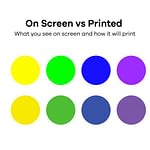When it comes to sleeve packaging design, color is one of the essential aspects to consider. According to the study, over 65 percent of the consumers buying decisions are influenced by colors. Thus, businesses must use the right color pallets for their custom printed box sleeves. That said, they should determine how they can achieve this vision on the press.
This prompts us to Pantone PMS and CMYK colors. One should know how these two differ from one another to make sure their sleeve boxes wholesale supply meets your expectations. Here we will shed more light on the topic and point out the best time to use them and how the two printing methods affect the printed packaging.
Table of Contents
What is Pantone Color?
A Pantone color is a universally standard color in the Pantone Matching System (PMS). Also known as spot colors or special inks. These are highly precise inks that are mixed together to create an exact color that can be consistently reproduced over and over again.
Similar to the paint color swatch book that is used to pick the paint colors for your home or dwelling, you can get a Pantone color book. The catalog of colors come into play when you are all set to print the final sleeve packaging design. Each color has a unique numeric identifier that consists of 3, 4, or 5 digits.
What is CMYK Color?
CMYK is also referred to as the ‘four-color process.’ It stands for the hues that are used in the printing process. These colors are yellow, black, cyan, and magenta. Each of the hues is printed separately on the printing press. One layered over the other to create a range of new colors.
Which is Better Pantone or CMYK?

The answer to this question depends on:
-
Your sleeve boxes wholesale supply design.
-
The chosen packaging material.
-
The printing method you will use.
-
Your budgetary provision.
-
Your expectations.
Here are a few scenarios and the best way to approach them:
What Happens When You Need an Exact Match?
In this situation, Pantone colors are highly desired because these colors come out the same in the press. The Pantone Matching System (PMS) also proves handy when a precise color match is required for a particular design element in the sleeve packaging design.
Pantone colors are often desirable in this situation because they look the same after printing. The PMS system works well when you need a precise color match for a particular element in the packaging design.
A perfect example would be brand or logo colors like Cadbury’s purple and Coca-Cola’s red. The challenge for these brands was to produce the same colors and controlled them independently from other rudiments in the design. But with Pantone, companies have successfully overcome this problem.
On the other hand, the problem with CMYK is it makes use of four different hues that are layered over one another to produce a new color. As a result, the margin of error is huge, as results could vary from press to press.
When You Want the Small Text and Logos to Appear Sharp?

By leveraging Pantone colors, you can prevent small logos and texts from appearing ambiguous. Especially when you are using a colored background with white text.
In contrast, the use of CMYK dramatically increases the risk because if the plates even shift slightly during the printing process. All your effort, time, and money will go down the drain. This will give you a design where colors will be bleeding into white areas.
Since PMS color uses just one plate, it diminishes the chance of bleeding.
Also Read:
Monster Musume Season 2 – Release Date
Showbox Alternative – The Best Sites

Be First to Comment